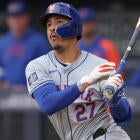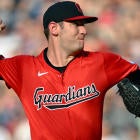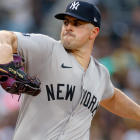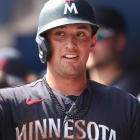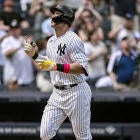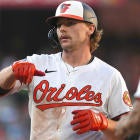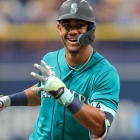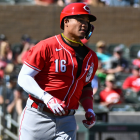For more Fantasy baseball insights, and to keep up with all the latest news, roster trends, and more throughout the season, subscribe to Fantasy Baseball Today now on iTunes, Stitcher, or Spotify. You can find us on YouTube now, with full episodes and clips available every Monday through Friday.
Recently, we came to learn what we expected all along: Vladimir Guerrero won't be on the Blue Jays opening day roster.
It's not for the precise reason we expected — he has a strained oblique — but the effect for the Blue Jays is the same. By holding him out until later in April, they can secure an extra year of team control.
There are a couple of key milestones that influence in-season call-ups. One comes in mid-April and the other in mid-to-late June, the oft-referenced Super 2 cutoff, when a team can delay the arbitration process and its salary-escalating ways. Those milestones are why so often the biggest-name prospects aren't given a fair shot to win a job in spring training. The financial consequences are too great.
For the most part, though, you can anticipate which prospects have the best chance of earning the call midseason. And in a deep enough format, stashing them ahead of that date, potentially even from the start of the season, can mean big rewards.
I'm not talking about, like, a standard 12-team Head-to-Head league, where the immediate payoff on the waiver wire is big enough already and the need for roster flexibility great. Maybe the first five of these prospects would be worth stowing away in such a format, but not all 14. Get in a league where 330 or more players are rostered, though, and virtually every prospect is on the table.
Note that I'm not counting the prospects expected to win jobs this spring, which means no Victor Robles, Francisco Mejia or Garrett Hampson, among others. I also haven't included the ones expected to begin the year on the IL, which eliminates Mike Soroka and Josh James. You'll have a special spot to stash them that won't require the use of your bench.
Among those looking at an actual demotion, though, here are my top 10 prospects to stash (apart from Guerrero, of course) in the hope of a 2019 impact.
Wait, didn't I say 14 before, as in the first five of these 14 might be worth stashing even in shallower leagues? Right, well, I'm adding four to the top because it's not clear yet whether or not they've won a spot on the opening day roster. If so, score! Instant rewards. If not, it'll happen soon enough that you should obviously still stash them.
Still on the bubble
These prospects are still in the mix for a spot on the opening day roster but would be obvious choices to stash if they don't make the cut.
Pete Alonso, 1B, Mets
2018 minors: .285 BA (478 AB), 36 HR, 119 RBI, .975 OPS, 76 BB, 128 K
The Mets have stated at every turn that they're taking the best players with them to New York, beginning with general manager saying at the start of spring training that he wants Alonso to be the opening day first baseman. Sure enough, the 24-year-old has been one of the stars of the Grapefruit League so far, so why am I still unsure? Because he's too big a part of the future for them to be so cavalier about his service time. And oh look, Dominic Smith is suddenly hitting again — easy excuse. I'm still scooping Alonso up as my corner infielder in most every league where such a spot is available because he's coming sooner than not. And his 80-grade power bat and plus plate discipline make a Rhys Hoskins-like outcome seem plausible.
Nick Senzel, 2B, Reds
2018 minors: .310 BA (171 AB), 6 HR, 8 SB, .887 OPS, 19 BB, 39 K
I won't walk us through every comment as I did in Sleepers 2.0, but manager David Bell has basically tipped the Reds' hand that Senzel is their one and only choice to man center field this season. Capability isn't a question anymore. It's just about when to start the service clock, and while they could make do with Scott Schebler out there for a time, their all-in mentality this offseason suggests Senzel could actually get the opening day nod. Either way, it's clear he's a mid-round target at this point, especially since he retains eligibility at one of the weaker infield positions. Rarely have a prospect's bat skills been so evident from his first day in the minor leagues, but that's what comes with being a No. 2 overall pick, as Senzel was in 2016.
Jesus Luzardo, SP, Athletics
2018 minors: 10-5, 2.88 ERA, 1.09 WHIP, 109 1/3 IP, 30 BB, 129 K
The Athletics declared well before the start of spring training that Luzardo was competing for a rotation spot, so now that he has struck out 15 in 9 2/3 innings while allowing just one earned run, what can they do but award it to him? Of course, the 21-year-old has only so many innings to expend, being just a couple years removed from Tommy John surgery and having only thrown 109 1/3 innings last year. So maybe they're thinking they'll just demote him later and cut back on the innings down there, which would make the service time issue less of a concern. He looks ready to dominate at the highest level, though, his fastball/changeup combination being well suited for strikeouts.
Chris Paddack, SP, Padres
2018 minors: 7-3, 2.10 ERA, 0.82 WHIP, 90 IP, 8 BB, 120 K
Speaking of dominating with a bananas changeup, Paddack has also made inroads this spring, striking out 14 compared to just two walks in 8 2/3 innings. It's that combination of command and deception that has moved him to the forefront of a wide-open rotation competition, with the 23-year-old himself dreaming of getting the ball on opening day. He faces greater workload concerns than Luzardo, though, being even more recently removed from Tommy John surgery and having thrown just 90 innings last year, but the same logic applies. The assumption with the two big call-up milestones is that the player is on the big-league roster the rest of the way, but the Padres could instead send Paddack down once they're ready to slow him down.
The top 10 otherwise
These prospects almost certainly aren't making the opening day roster but have a good chance making a Fantasy impact at some point this season.
1. Eloy Jimenez, OF, White Sox
2018 minors: .337 BA (416 AB), 22 HR, 28 2B, .961 OPS, 32 BB, 69 K
The first off the board other than Guerrero would probably go a few rounds earlier if there wasn't so much attention paid to the other-worldly hitting ability of his Blue Jays counterpart. Truth is Jimenez's bat skills — namely the combination of contact and power hitting — are nearly as eye-popping and would make him the object of every upside chaser's affections in a typical, Guerrero-less prospect pool. He, like Guerrero, seems like an obvious candidate to promote after the mid-April cutoff for securing an extra year of team control, but of course the White Sox can't outright say it without incurring the wrath of the player's union. It's worth noting, though, Jimenez has had a rocky spring so far and will need to hit the ground running at Triple-A to follow through on that timetable.
2. Fernando Tatis, SS, Padres
2018 minors: .286 BA (353 AB), 16 HR, 16 SB, .862 OPS, 33 BB, 109 K
Spring performance has moved Tatis up a couple notches on this list, as has the Padres' decision to sign Manny Machado. And while we're at it, let's throw in the emergence of several exciting young arms this spring. Clearly, there's a path to contention for this team, what with the Giants and Diamondbacks both being out of it, and having Tatis replace Ian Kinsler once he proves ready can only improve those odds. The 20-year-old has a lot in common with Machado, actually, and could provide an enticing power/speed combination from the get-go. Even if he's not asked to run as much in the majors, the power alone could elevate him to must-start status.
3. Kyle Tucker, OF, Astros
2018 minors: .332 BA (407 AB), 24 HR, 20 SB, .989 OPS, 48 BB, 84 K
2018 majors: .141 BA (64 AB), 1 3B, 2 2B, 1 SB, .439 OPS, 6 BB, 13 K
Spring training giveth and spring training taketh away. Tucker put up such impressive numbers during the exhibition season last year that teammates took to calling him "Ted," but this year he showed up with no hope of winning a job and performed like it. The 2018 numbers would suggest he has nothing more to learn in the minors, and he made consistent contact during his stint in the majors. But as the Houston Chronicle puts it, he needs to do a better job of making hard contact on inside pitches during this era of infield shifts. Still, he's already on the 40-man roster, so if Michael Brantley gets hurt again, Josh Reddick continues to decline or Tyler White doesn't pan out at DH, you can bet Tucker is on his way up.
4. Forrest Whitley, SP, Astros
2018 minors: 0-2, 3.76 ERA, 0.99 WHIP, 26 1/3 IP, 11 BB, 34 K
Whitley appeared to be on the same track as Walker Buehler at the start of spring training a year ago, meaning a 2018 debut seemed like it was in the cards for him as well, but a 50-game suspension for a drug violation at the start of the season followed by a lat injury at the end pretty much made it a lost cause. The ability is obvious, though, beginning with his Noah Syndergaard-like arsenal, and while the Astros would seem to have a number of rotation redundancies already, particularly once Josh James is healthy, they'll have a hard time holding Whitley back when he's striking out 14 per nine in the minors.
5. Tyler O'Neill, OF, Cardinals
2018 minors: .311 BA (238 AB), 26 HR, 1.078 OPS, 29 BB, 68 K
2018 majors: .254 BA (130 AB), 9 HR, .803 OPS, 7 BB, 57 K
O'Neill doesn't have quite the ceiling of some of the other prospects on this list given that power is pretty much all he brings to the table, but oh is there power. So much power. Project his home run pace in the minors last year over 160 games, and it comes out to 65. And though he'll have to cut down on the strikeouts in the majors, he has already shown he can be useful there, too. Problem is the Cardinals want to try to redeem Dexter Fowler, given how much money he's still owed, and need to find at-bats for Jose Martinez as well, so the path for O'Neill isn't so clear. Eventually one will open, though, and he may not look back.
6. Keston Hiura, 2B, Brewers
2018 minors: .293 BA (485 AB), 13 HR, 34 2B, .821 OPS, 36 BB, 103 K
Part of the reason the Brewers made only a one-year commitment to Mike Moustakas as their starting second baseman is because their top prospect happens to play that same position and is on the verge of breaking through. Hiura boasted one of the most refined bats of any player selected in the 2017 draft but had to overcome an elbow issue before putting it on full display. He did, and it was as advertised, propelling him all the way to Double-A last year. Because the Brewers are already acknowledging Moustakas' poor range at second base, saying they'll compensate for it by carefully aligning their infield, I'm thinking Hiura won't have much trouble bumping him to the bench if he proves ready midseason.
7. Brent Honeywell, SP, Rays
2017 minors: 13-9, 3.49 ERA, 1.24 WHIP, 136 2/3 IP, 35 BB, 172 K
Honeywell seemed poised to compete for a job in the Rays rotation last spring before succumbing to Tommy John surgery in February, but February was early enough that he can take his time rehabilitating and still make an impact midseason. He has been throwing all his pitches since January and recently faced live hitters for the first time, so it sounds like he's not so far from building up to pitch again. He commands five pitches, including a screwball, and has a good idea how to attack hitters. If the Rays compete as expected this year, he's someone who could give them a big boost down the stretch.
8. Nate Lowe, 1B, Rays
2018 minors: .330 BA (482 AB), 27 HR, 102 RBI, .985 OPS, 68 BB, 90 K
The plan as of now is for the Rays to go the piecemeal route at first base, using some combination of Ji-Man Choi, Yandy Diaz and Brandon Lowe. But those players are either capable of playing other positions or ... they're Ji-Man Choi. Bottom line is that when Nate Lowe is pushing for a promotion, there won't be much standing in his way. And with the strides he made last season, going from organizational depth to offensive powerhouse with a swing adjustment that allowed him to turn on inside fastballs, Triple-A probably won't be what slows him down. A poor spring showing hasn't helped his cause, but it's just a drop in the bucket in the grand scheme of things.
9. Brendan Rodgers, SS, Rockies
2018 minors: .268 BA (426 AB), 17 HR, 12 SB, .790 OPS, 31 BB, 92 K
Though he was mentioned as part of the competition and is considered the best prospect of the three, Rodgers never had a shot of beating out Garrett Hampson or Ryan McMahon for the starting second base job. He hasn't shown much this spring, but the contact rate would suggest he's not overmatched. If the 22-year-old continues his steady climb up the ladder, which began when the Rockies took him third overall in 2015, this year ends with him in the majors, and it's not exactly difficult to envision how. Let's say Hampson emerges in a super utility role, freeing up second base for McMahon, but then Daniel Murphy gets hurt, shifting McMahon over there. Boom, Rodgers is your starting second baseman, and the bat skills should play up in an environment like Coors Field.
10. Yusniel Diaz, OF, Orioles
2018 minors: .285 BA (354 AB), 11 HR, .841 OPS, 59 BB, 67 K
Cedric Mullins looks like he could be a long-term fit for the Orioles in center field, and the re-emergence of Austin Hays this spring locks up another spot. But projected left fielder Trey Mancini could easily move to first base or DH to make room for Diaz, the biggest piece acquired in the Manny Machado deal last season. Diaz makes a ton of contact, and though his minor-league home run totals leave a bit to be desired, players with his kind of bat skills have a tendency to find their power strokes in the majors, especially given the current offensive climate.
So which Fantasy Baseball sleepers should you snatch in your draft? And which undervalued pitchers can help you win a championship? Visit SportsLine now to get Fantasy Baseball rankings for every single position, all from the model that called Scooter Gennett's huge breakout last season, and find out.









